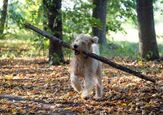Dog Lost in the Woods? Here's How to Find Him Quickly!

(photo credit: StockPhotoArt / shutterstock.com)
Don’t you love the heartwarming stories of dogs that are found after being lost for days, weeks, months and even years? Or the ones that travel hundreds of miles to make it home to their families? While they’re definitely upbeat, feel-good stories, make no mistake, I’m determined to avoid ever having to experience the anxious waiting and worry that those pet parents would have had to endure. And unlike losing a dog in a populated, urban area, having them go missing when away from home or worse, in the wild, takes on a whole new sense of urgency.
My guess is that many pet owners would be hard-pressed to say their pooch had the survival instincts needed to get through more than a few days without food, water, shelter, and warmth. Not to mention having the innate skills needed to evade predatory wildlife.
So, when you’re in the great outdoors, keeping your dog visible and/or within calling range is important, but equally so is knowing how to quickly track him down when he takes off and isn’t responding to your calls.
Prevention
According to the American Kennel Club (AKC), the first step in safeguarding your pet from becoming lost is to prevent it from ever happening, and that includes:
- using GPS collars
- training
- leashing or securing
While micro-chipping is a no-brainer in an urban environment where a good Samaritan can find your little buddy and take them to a local vet or animal services for scanning, it’s not an option when you’re in a heavily rural or wilderness area.
That leads us to GPS collars like this option from Tractive XL, which allows you to establish a virtual fence alert that will flag you if your pooch steps outside of your preferred boundaries. Perfect for camping or remote cabins. Or the popular Apple AirTag that, when paired with an appropriately designed AirTag dog collar, is easy to slip on before hiking and allows you to track your pet if he suddenly takes off after who-knows-what. These options are perfect for us pet owners who love to camp, hike, and travel because let’s face it, keeping track of our four-legged companion at all times can be a challenge. Especially when off-leash is the order of the day and our pet is high-energy or has hearing/vision issues that make recall a little more challenging.
AKC stresses the importance of training your pooch on basic commands – particularly recall (come!) and sit or stay to help ground him when he starts to venture a little too far.
And lastly, if you want to enjoy the wilderness without allowing your dog to roam off-leash, consider using a heavy-duty ground stake like this option from Petbobi that anchors securely into the ground and includes a 30-foot steel wire lead to give him a sizeable space to wander around but not wander off. Or, opt for the freedom of a longer lead like this 15-foot dog leash that gives your pooch room to go exploring off the beaten path but without venturing too far away.
Recovery
So, how and where do you begin to search for your dog if you’re enjoying the great outdoors and he’s suddenly not responding to your calls?
Start with the Basics.
Retrace your steps and the route you took when you first set out. Don’t continue walking and assume you’ll eventually catch up with one another. The longer he’s missing, the more likely he’ll pick up other scents and head off in different directions. And in case he was spooked and is feeling anxious, be sure to call his name in an upbeat, friendly manner that encourages him to surface, versus a disciplinary style that might cause him to hide or feel he’s in trouble.
Leave a Trail for Him to Pick Up.
Dogs have such an amazing number of olfactory scent receptors (125-300 million compared to humans who have just 5 to 6 million) that tracking a scent they know (you or maybe their favorite treats) will be second nature. Leaving him a trail of items that lead back to you, your camp, or your car will help him get back on track faster. A glove, a scarf, a headband, one of his toys, his favorite treats… just a small item from which he can pick up your scent. If leaving a treat trail, go back to replenish each morning – because overnight critters are sure to enjoy.
And be aware of weather conditions – a light snow or rain can begin to blur scents and make it more difficult to reconnect.
Let People Know.
If you’re in a conservation area with notice boards, post the date and last known sighting along with your contact details. Local towns will also have veterinary offices and animal services that you can flag to be on the lookout, as well as local papers with online readership, where you can post information. Social media is great for urban settings, but may not be as effective in more remote locales. That said, if you are in an area popular for hiking and camping, be sure to seek out related social media sites and post an alert for anyone who will be visiting the area.
Leave a Food and Water Station.
Yes, other wildlife will likely enjoy this offering overnight, but if you still have hours of daylight and worry your pet may get hungry, thirsty, or cold (particularly if they’re older), leaving their bowl with familiar kibble as well as water and a blanket in the area where they were last seen may help draw them out.
Choose Your Search Times.
Dogs are typically more active in the morning and evening, then sleep throughout the day. So, while you’ll unquestionably be searching throughout the entire day, make a point of starting at dawn and ending later, after dusk, when he is more likely to be up and moving around rather than resting.
Organize a Small Search Party.
Particularly if you’re dealing with a larger footprint, the more eyes on the ground, the better. Ideally, you should assemble people your dog will recognize and come to easily, but when time is of the essence, searchers who know your dog’s quirks and arrive armed with treats can alert others to a sighting and will help make quick work of any search.

Sharing space with three seriously judgy Schnoodles and 2 felines who prefers to be left alone. #LivingMyBestLife
More by Mary Simpson

























